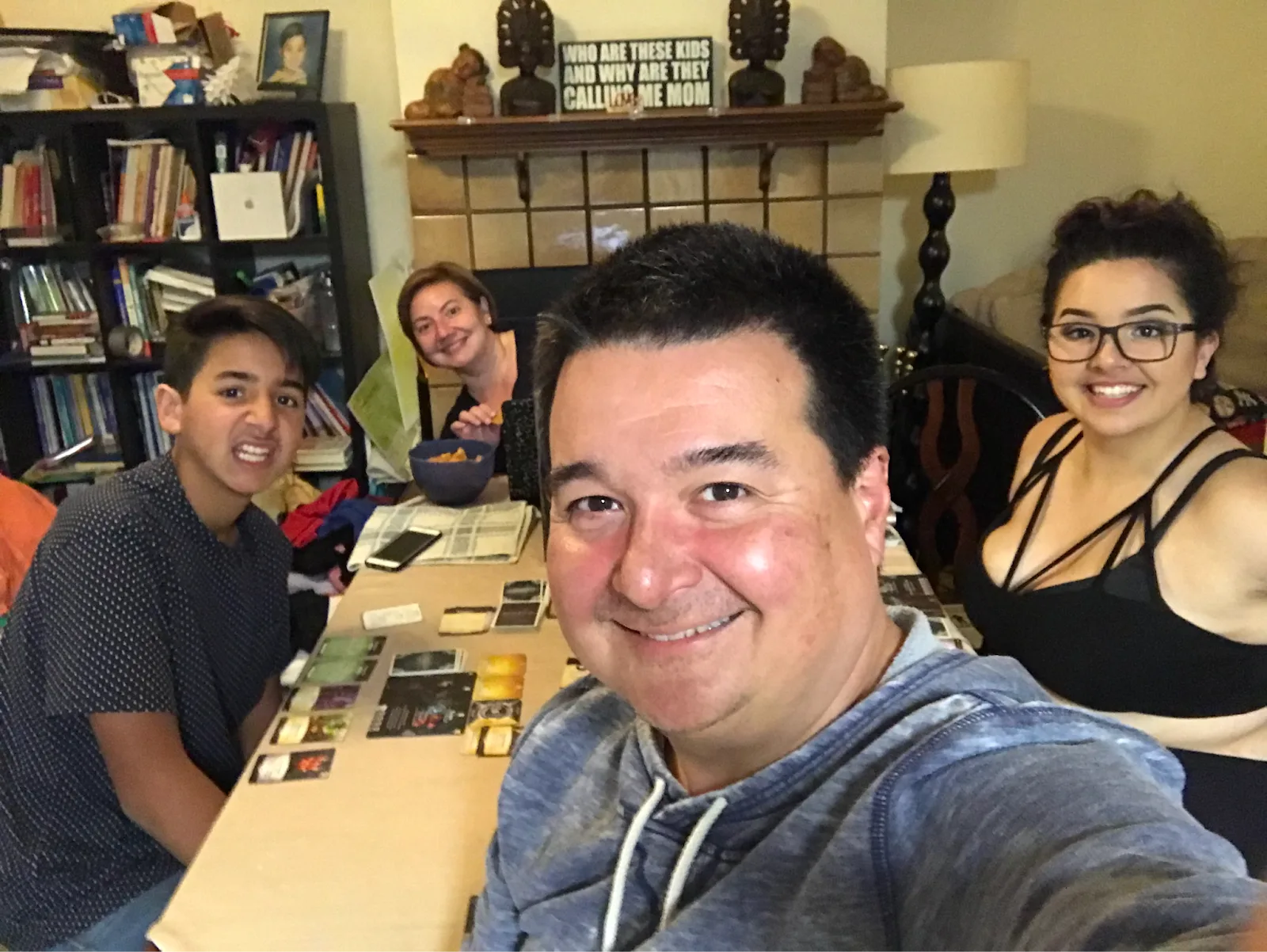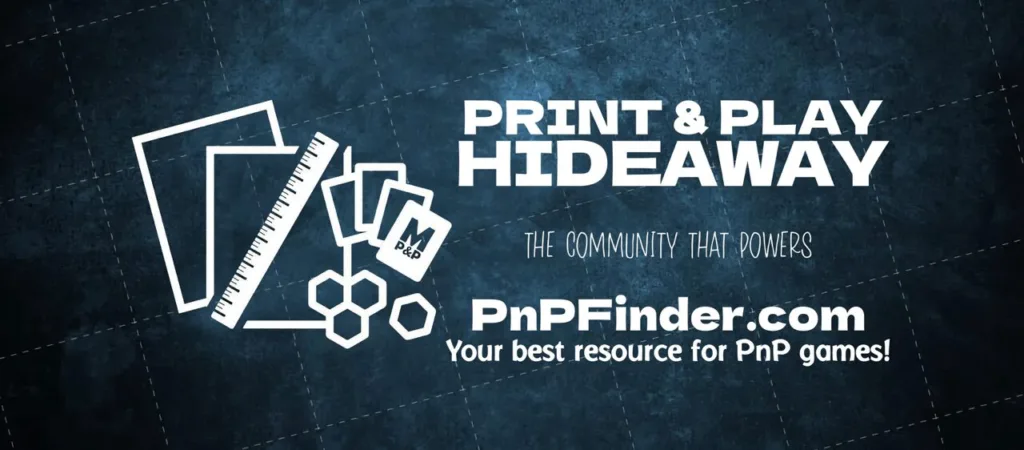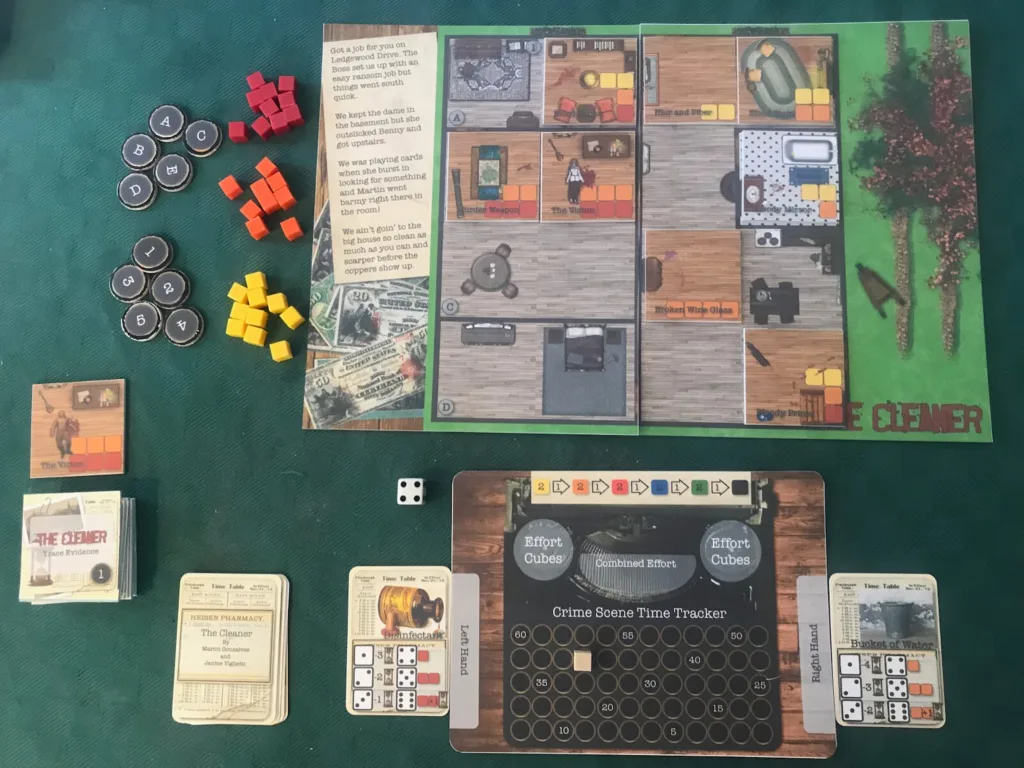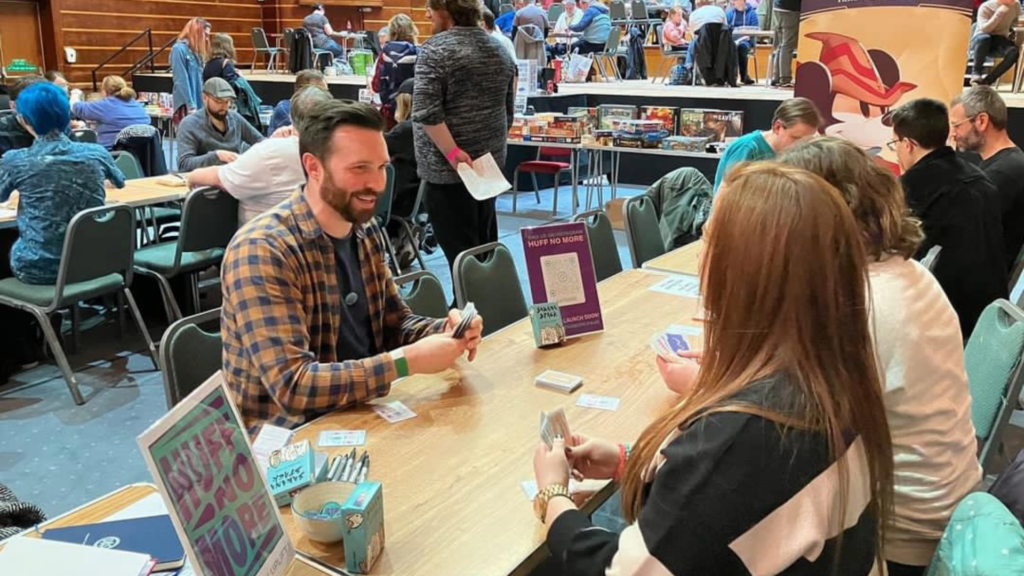Welcome back to the What If? blog. Today I’m chatting with Martin Gonzalvez, a name you might recognise if you’ve spent any time in the print and play community. What started as a simple way to save money on his growing board game collection has evolved into something much bigger. Martin now runs the Print and Play Hideaway Facebook group with over 14,000 members, moderates the r/printandplay subreddit, and has crafted over 200 PnP games himself – he’s somewhat of an expert!
In our conversation, we dive into Martin’s journey from family gaming nights to becoming a solo gaming enthusiast, explore the fascinating world of print and play game design contests, and discover how COVID transformed the PnP landscape. Whether you’re curious about the crafting side of gaming or interested in how online communities form and thrive, Martin’s insights into this often-overlooked corner of the hobby are genuinely eye-opening. We’ve also got other articles and interviews about pnp games, I’ll share the links at the end of the interview.
Enjoy.
Joe: Hi Martin. Welcome to the What If blog. Can you start by telling me a little bit about yourself? Who are you and what brings you to the world of games?
Martin: Hi Joe! My name is Martin Gonzalvez, and I came to the world of hobby games back in 2017. It was my oldest son, then 25, who introduced me to hobby games with FFG’s Eldritch Horror. This game interested me because it reminded me of my college days, when I used to play Chaosium’s Call of Cthulhu TTRPG with my friends. After graduating from school, I got busy with work and family (I have a wife and four grown-up kids), and gaming was not on my radar until my son dragged me into it. After this initiation into hobby gaming, I fell deep into the rabbit hole. I discovered deck-building games early on in my gaming journey, Star Realms and Hero Realms, and these quickly became favourites. Harry Potter: Hogwarts Battle was a game that I spent many hours enjoying with my kids. My daughter and I eventually graduated to Stonemaier Games’ Scythe, which was fairly new and popular at the time.

The Gonzalvez family playing Aeon’s End in March 2018
Inevitably, the kids grew up and moved on, and since my wife is not into playing hobby games with me, I evolved into becoming a solo gamer. My collection of soloable games really started to explode around this time, up to the present when I have around 400 or so games in my collection. Among my favourites from this era are Lost Ruins of Arnak, Wingspan, Fantastic Factories, The Manhattan Project: Energy Empire, and Newton. I developed an appreciation for soloable midweight worker placement Euro games.
Joe: What initially drew you to the solo gaming aspect, and how has your approach to building your collection changed as you’ve become more experienced?
Along the way, I also became heavily involved in the print and play sub-hobby. To date, I have crafted over 200 PnP games, many of them rather large projects. I have a YouTube channel (Print and Play Hideaway) where I have uploaded over 140 videos over the years, most of them focused on the topic of PnP games and techniques. I am also the admin of the Print and Play Hideaway Facebook group, which now has over 14K members.

More recently I also became co-moderator of the r/printandplay subreddit, with over 12K members. I have also gotten into the hobby of creating my own free PnP rethemes of existing games, having made over 30 of them over the years. Finally, I have designed several free PnP games: The Cleaner, The Mintese Falcon, Do Not Go Gentle, and Super Robo Jetkaiser Z, my current entry to the 2025 Solitaire Print and Play Game Design Contest, and my most complex and ambitious game design yet.
Joe: Thanks Martin, that’s an incredible list of projects. Before we dive into the world of PnP and unlock some of your expertise, I wonder if you can tell me what has driven you to dive so deeply into the genre, and to become someone who builds community around games rather than just plays them?
Martin: That’s a good question. I started exploring PnP games about 8 years ago. My initial motivation was that I felt that I was spending too much money collecting published retail games. I was exploring PnP games as a way of satisfying the board game acquisition monster in my belly, without having to spend more money. The more that I explored, the more amazed I became at the sheer number and diversity of fascinating PnP games. I learned not only about premium quality PnP classics like Maquis, Black Sonata, and Deep Space D-6, but I also learned of the incredible world of PnP game design contests on BoardGameGeek.
I was exploring PnP games as a way of satisfying the board game acquisition monster in my belly, without having to spend more money
I was mind-boggled to discover a hidden world of indie PnP game designers, incredibly dedicated and talented, joining contests for no other motivation than to share their game designs, read each others’ rulebooks, playtest each others’ designs, provide feedback, share knowledge, learn from each other, and lift each other up. I found it to be a wonderfully supportive and close-knit community of indie PnP game designers, and I couldn’t wait to become a part of it myself. I joined the 2018 Solo PnP Game Design Contest, knowing less than nothing about what it means to be a game designer or to design a game. I mean, my first prototype was super rough and atrocious. But I put myself and my ideas out there, and fortunately, my WIP thread caught the attention of Janine Viglietti, who is an amazing graphic designer, and has become a successful game designer in her own right. Janine eventually became my co-designer, collaborator, and partner-in-crime on The Cleaner, and we did rather well in the contest – 7th place overall best game, 1st place best PnP build, 2nd place best rulebook, 3rd place most thematic game, Janine took 1st place as best artist, and I took 3rd place for best designer. It was such an awesome first contest experience for me. And it opened my eyes and my mind to the power of community among PnP game designers.

Early prototype build of The Cleaner, co-designed by Martin Gonzalvez and Doc Janine Viglietti, art and graphic design by Janine Viglietti.
The rest of the story isn’t as warm and heartening. Long story short, I became a passionate and devoted member of the PnP community. I was a member of what was then the largest PnP group on Facebook. However, I turned out not to have a great experience being a part of that group in the end. I did not agree with how the group was being moderated. In my conceit, I felt that I could do a better job running a PnP group. That’s when I decided to start the Print and Play Hideaway on Facebook. We stand for many things in our group, but above all else we wanted to create a space that is kind, welcoming, helpful (especially to PnP newbies), and guided by principle. We love the PnP hobby, and we want to share it with as many people as we can, in a positive way, and through PnP form genuine human connections. The kind that are all too rare on social media. And I think people have recognised and responded to what makes the Hideaway a special place. For one thing, we now have more members than that other PnP group I mentioned earlier. 😉
We stand for many things in our group, but above all else we wanted to create a space that is kind, welcoming, helpful.
The epilogue to the story is that many years ago, I had the temerity to share pictures of some of my PnP retheme projects on the r/printandplay subreddit. I wasn’t too familiar with that subreddit, I didn’t spend much time on Reddit. I didn’t really understand Reddit at the time, truth be told. But I figured, one PnP group is similar to another, and so I thought to try to build a bridge of connection between the Hideaway and that PnP subreddit. And the moderators promptly slapped me with a lifetime ban! Apparently they didn’t bother to read my posts too closely, and interpreted my posts as “spam” and a bunch of other negative things that were entirely untrue. Well, once my lovely and passionate Hideawayers got wind of how I had been treated by the mods of that subreddit, they closed ranks around me and formed an angry mob armed with virtual torches and pitchforks, and went off to educate those mods about who exactly they had slapped with an unfair lifetime ban. So my lifetime ban was lifted, those mods apologised for treating me that way, and after how I had been treated, I resolved to have nothing to do with that PnP subreddit. Fast forward a few years. Those mods were long gone. Apparently the PnP subreddit had fallen into a mod-less, rudderless, sad existence. And one of the members reached out to me to ask if I would be interested in moderating that PnP subreddit. And that’s the story of how I eventually became the moderator of the very same subreddit that had once slapped me with a lifetime ban. What tangled webs we weave, indeed. 🙂
Joe: Thanks Martin. That’s quite a journey you’ve been on. I’m happy that you’re currently in such a positive place with it though. I’m not a Facebooker, but I do spend time on the subreddit and I can see the care that goes into it, so thank you for that.
You’ve touched a little on the PnP genre, particularly your own reasons for diving into that side of the hobby so I wonder if we can explore that a little further.
Can you tell us a little of the history of PnP games?
Martin: Sure, as much of it as I can recall or know about. As I said earlier, I started exploring PnP games about 8 years ago, around 2017. The first PnP game I learned about and crafted was Agent Decker by Manuel Correia, which took 2nd place in the 2015 Solo PnP Game Design contest. Another early prominent PnP game was Utopia Engine by Nick Hayes (2010). When I joined the PnP scene, the main place to get news on new and interesting PnP games was the Print and Play Games News blog by Chris Hansen. He provided excellent regular coverage of the PnP scene from December 2012 to June 2020. The blog has been on hiatus since then.
Another link to the history of PnP games is the Monthly Print and Play Crafting Geeklist, which started in June 2010, and which the PnP community has been keeping alive every month since then until today. I myself took on the duty of regular monthly host of the crafting geeklist from August 2020 until December 2024. Since then, we have been having a cast of rotating guest hosts from the PnP community. Still another long-running connection to PnP history is the geeklist Kickstarters with PnP versions available (& other crowdfunding), which remains regularly updated today. The first entry was posted in November 2012. I mentioned earlier some classic PnP games such as Maquis (2013) by Jake Staines, but perhaps the earliest true PnP game that became prominent and well-known as a PnP classic was Jeremiah Lee’s Zombie in My Pocket, the first edition was released in 2007! So that’s my very brief history of PnP games. 🙂
Joe: Thanks Martin. There’s plenty for us to check out.
From your experience running the PnP forums on Facebook and moderating the r/pnp, what is it about the genre that’s really switching people on?
Martin: The COVID lockdown was a game changer for the PnP hobby. Millions of people were suddenly stuck at home with little to do, and many were searching for a variety of ways to fill their at-home time. A number of prominent game publishers moved to fill this gap, notably Stonemaier Games with Rolling Realms. Mainstream and casual board gamers were opened up to the idea that you could print a couple of pages at home, supply some dice and a pen or pencil, and you were rewarded with a fun, diverting, well-designed game for a few minutes or hours of entertainment.

This in my opinion has led to the rise of roll and write games coming to predominate the print and play scene, for better or worse (depends on who you ask). There are a number of game designers and publishing outfits now that focus on print and play as a regular way to distribute their game designs, either through crowdfunding, via PnParcade, itch.io, or more traditional web stores. The higher quality of these would include Postmark Games, helmed by game industry veterans Matthew Dunstan and Rory Muldoon. They represent the best and most worthwhile games of the post-COVID PnP scene, in my opinion. There are others at the lower end of the quality spectrum (that I shall refrain from identifying here), pumping out AI-slop generated, derivative, exploitative PnP roll and write games by the dozens to take advantage of the current popularity of the genre, and you can tell by my choice of adjectives what I think of such types polluting the waters of the PnP scene with their prodigious, low-quality output. Enough said about that. Suffice to say, post-COVID, to some newcomers, the entirety of the PnP scene seems to be synonymous with “PnP roll and write games”, which is not the case.
Print and play is really multiple hobbies in one. Not only do you play the game, but you also craft it. In fact, there’s a meme in the PnP scene where some people are focused (one might say addicted) to the crafting aspect, but then never get around to actually playing the games that they craft. Sort of analogous to some non-PnP board gamers who buy games but never get around to playing some of them, leading to the phenomenon of the “shelf of shame”. That’s a thing for some people in PnP as well.

It’s hard to find pictures of me crafting a game, because when I’m in the process of crafting a game, there’s no one around to…take a picture. Here’s a still image of me in early 2019 demonstrating how to carefully remove chipboard tokens created on my Cricut Explore Air 2.
There are a rarefied few in the PnP scene who enjoy the extreme crafting challenge of a complex PnP game with lots of varied components: cards, boards, folding boards, tiles, custom dice, standees, miniatures, 3D-printed elements, woodcrafting elements, etc. I am one of these people. I get a thrill out of crafting a large, complex, beautifully rendered game out of humble raw materials. I like it when I show off my work and most people can’t tell that what I have made is a PnP project. This crafting-forward side of the PnP hobby is not for everyone. It requires a lot of time, practice, patience, specialised tools and materials, and lots of mistakes. But for those few of us (fewer and fewer as time goes on, it seems to me) who like the extreme crafting side of the PnP hobby, there are few things in life that we find more fulfilling than working on and finishing a large and challenging PnP project.
PnP is a big tent that welcomes everyone.
I’d like to end my answer to this question on the idea that PnP is a big tent that welcomes everyone, no matter if you’re into extreme crafting, or you’re at the other end of the spectrum and just want to print a couple of pages and play a simple game. And includes everyone between those two extremes. It’s a positive hobby that engages both body and mind, presents us with good problems to solve and enjoy, and connects us to a diverse community of people who enjoy the humble hobby of print and play.
Joe: I hadn’t properly thought about the crafting side of the game, and that that in and of itself could be a main reason for the hobby. But when I think about it, I love that crafting aspect myself!
To finish off, tell people where they can find you and the wonderful communities you support on the internet.
Martin: You can find me on YouTube at https://www.youtube.com/@PnPHideaway. You can geekmail me “@DrHenryArmitage” on BoardGameGeek. Check out the monthly PnP crafting geeklist on BGG. I moderate https://www.reddit.com/r/printandplay/ on Reddit. I’m on https://www.facebook.com/groups/pnphideaway. And finally, check out http://pnpfinder.com as your best one-stop shop to search for and discover the best print and play games, as curated by the PnP community. Thanks for this opportunity! I really appreciate it and have enjoyed answering your questions.
Thanks so much to Martin for taking the time to share his story and expertise with us. It’s fascinating how what began as a cost-saving measure has grown into such a vibrant community and creative outlet. Martin’s passion for both the crafting and community sides of print and play really shines through, and I think his approach to building welcoming spaces online is something we could all learn from.
If today’s conversation has sparked your interest in the print and play world, you’ll definitely want to check out the interview with Postmark Games and my series on PnPs here. And of course, do explore the communities Martin mentioned, whether you’re interested in simple roll and write games or complex crafting projects, there’s clearly a place for everyone in the PnP tent.
Oh, and sign up to the mailing list to get next week’s interview!


